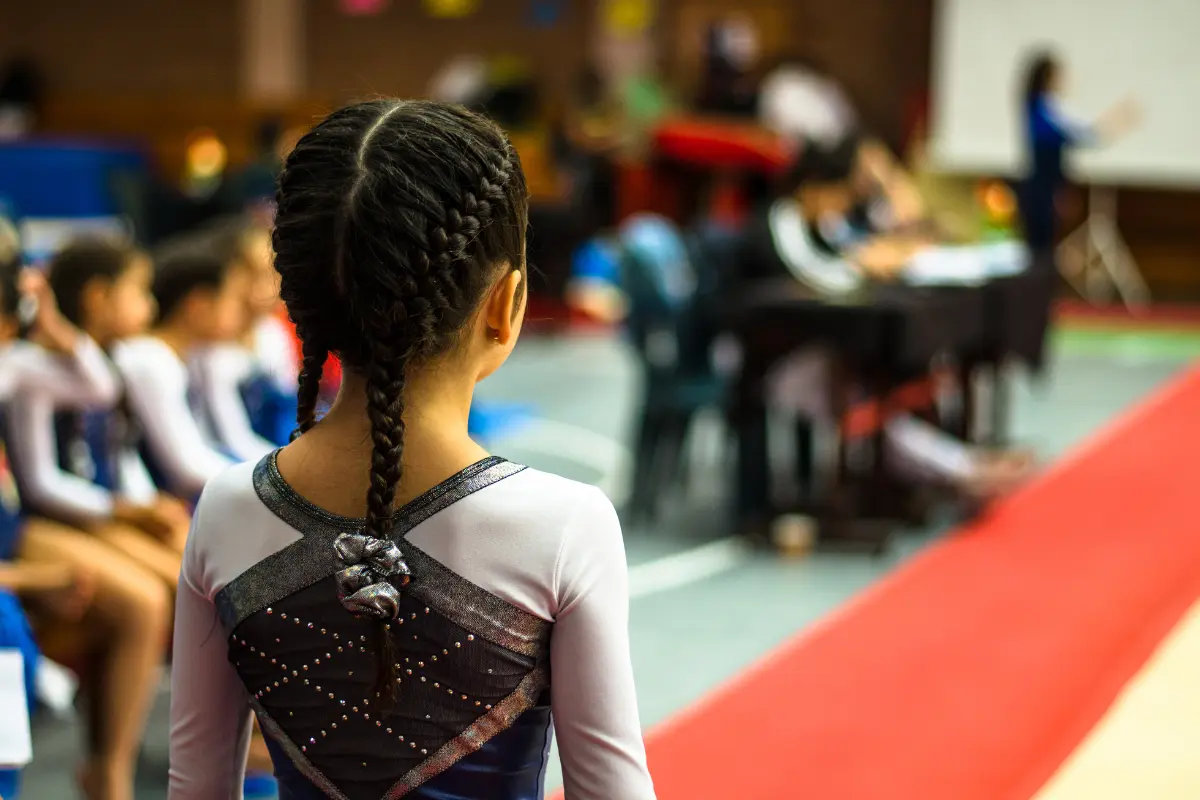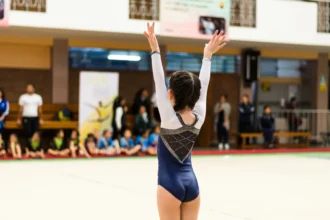Every Olympic cycle sparks the same debate: which sport is the hardest? With its rare mix of artistry, strength, flexibility, and mental toughness, gymnastics almost always enters the conversation.
But is it truly the hardest Olympic discipline? To find out, we need to define what makes a sport “hard,” then compare gymnastics with other events that test athletes to their limits.
Defining “Hardest”: What Factors Count?
Before we can compare, it’s important to clarify what “hardest” really means. A few dimensions stand out:
- Physical Demands – The combination of strength, endurance, flexibility, coordination, and power required.
- Technical Complexity – The number of skills involved, the precision they demand, and the margin for error.
- Injury Risk – The likelihood of serious injury, whether from mistakes or long-term overuse.
- Time Investment – How early athletes must begin training and how many hours are required to reach elite level.
- Psychological Pressure – The mental toughness, focus, and ability to perform under the Olympic spotlight.
Gymnastics scores high in all five categories, but how does it compare with other contenders?
Gymnastics: The Case for Hardest
Physical Demands:
Gymnasts must be complete athletes. Vault requires explosive sprinting and leg power, rings demand unmatched upper-body strength, beam tests balance and flexibility, and floor combines endurance with artistry. Elite gymnasts train 25–30 hours per week, making them among the most all-around conditioned athletes in the Games.
Technical Complexity:
The skill set is vast. A routine may include flips, twists, releases, and dismounts with razor-thin margins for error. One step out of bounds or a missed grip can cost everything. Moves like Simone Biles’ Yurchenko Double Pike vault or a triple-twisting dismount off bars show just how high the ceiling is.
Injury Risk:
The sport ranks among the highest for injuries. From stress fractures and torn ACLs to falls off apparatuses, gymnasts face risks both acute and long-term. The pounding from landings adds another layer of wear and tear.
Time Investment:
Most gymnasts begin before age five. Peak competitive years often arrive in the teens or early twenties, leaving a narrow window for success. Few sports require such early specialization and lifelong dedication.
Psychological Pressure:
Routines are short, often under 90 seconds, yet they define years of preparation. One wobble on beam or slip on bars can erase medal hopes. The mental resilience required is extraordinary.
Comparing to Other Tough Olympic Sports
Plenty of other Olympic sports are also brutally demanding. Here’s how they stack up against gymnastics.
Weightlifting
Why it’s tough: Olympic lifters pursue the perfect blend of strength and power. The snatch and clean-and-jerk demand explosive force, balance, and years of drilling. Training is relentless, and injuries to the back, knees, and shoulders are common.
Where it differs: Weightlifting is highly specialized. While technical, it lacks the artistry, choreography, and aerial risk that make gymnastics so multi-dimensional.
Swimming
Why it’s tough: Swimmers train at staggering volumes, often twice a day. Endurance, speed, and efficiency are key, and races can come down to a fingertip. Perfecting strokes, starts, and turns takes years of repetition.
Where it differs: Intense but lower-risk. Swimming doesn’t require extreme flexibility or high-risk acrobatics, and gymnasts usually must specialize much earlier.
Wrestling
Why it’s tough: Matches are short but exhausting, demanding constant grappling, explosive counters, and raw strength. Conditioning is brutal, and mental toughness is essential.
Where it differs: Wrestling relies on power and technique, but the skill variety is narrower than gymnastics. Wrestlers also tend to start later than gymnasts, who peak early.
Rowing
Why it’s tough: Few sports punish the body like rowing. Training pushes both aerobic and anaerobic systems to the limit. In team boats, perfect synchronization adds to the grind.
Where it differs: Movements are repetitive, and while overuse injuries are common, the catastrophic risks of gymnastics landings and releases aren’t present.
Figure Skating (Winter Olympics, but often compared)
Why it’s tough: Skaters must combine athleticism with artistry, landing triple and quadruple jumps, executing spins, and performing to music — all on ice. One slip can ruin a routine.
Where it differs: Similar in artistry and technical skill, but across fewer disciplines. Gymnastics requires mastery of multiple apparatuses and a wider range of movement.
Track & Field (Decathlon/Heptathlon)
Why it’s tough: Decathletes and heptathletes are ultimate all-rounders, competing in 10 or 7 events that test speed, strength, and adaptability. Two-day competitions are as much mental battles as physical ones.
Where it differs: Demanding in range, but doesn’t require the flexibility, artistry, or aerial awareness central to gymnastics.
Boxing
Why it’s tough: Boxing mixes endurance, explosive striking, and sharp reflexes. Training is grueling, with hours of sparring and conditioning. Each bout tests physical and mental toughness.
Where it differs: Fiercely physical, but it doesn’t combine artistry or multi-apparatus acrobatics like gymnastics.
Water Polo
Why it’s tough: Athletes swim sprints, tread water constantly, and wrestle opponents while running plays. It’s a brutal blend of endurance, strength, and tactics.
Where it differs: Physically punishing, but the skill set is narrower and lacks the aerial or choreographic demands of gymnastics.
Triathlon
Why it’s tough: Triathletes must master swimming, cycling, and running. Races last hours, testing stamina, adaptability, and focus across three disciplines.
Where it differs: Purely endurance-based. It doesn’t involve artistry or the high-risk aerial maneuvers of gymnastics.
Marathon Running
Why it’s tough: Running 26.2 miles at near top speed takes extraordinary discipline. Training involves massive mileage and extreme mental toughness.
Where it differs: Grueling but one-dimensional. It doesn’t demand explosive power, flexibility, or complex choreography.
Judo
Why it’s tough: Fast, tactical, and explosive, judo requires sharp reactions, timing, and years of technical drilling. Every match is physically punishing and strategically complex.
Where it differs: Technical, but focused on throws and grappling. It doesn’t blend artistry, acrobatics, and apparatus mastery like gymnastics.
Quick Comparison Table
| Sport | Physical Demands | Technical Complexity | Injury Risk | Training Years | Mental Pressure |
|---|---|---|---|---|---|
| Gymnastics | ⭐⭐⭐⭐⭐ | ⭐⭐⭐⭐⭐ | ⭐⭐⭐⭐ | Start very young | Extreme — one mistake can end a medal run |
| Wrestling | ⭐⭐⭐⭐⭐ | ⭐⭐⭐ | ⭐⭐⭐ | Youth start, peak 20s | High |
| Boxing | ⭐⭐⭐⭐ | ⭐⭐⭐ | ⭐⭐⭐⭐⭐ | Youth start, long prep | Very high |
| Rowing | ⭐⭐⭐⭐ | ⭐⭐ | ⭐⭐ | Long hours, peak later | High |
| Swimming | ⭐⭐⭐⭐ | ⭐⭐⭐ | ⭐⭐ | Early start, long hours | High |
| Decathlon / Heptathlon | ⭐⭐⭐⭐ | ⭐⭐⭐⭐ | ⭐⭐ | Years of multi-event training | High |
| Triathlon | ⭐⭐⭐⭐ | ⭐⭐ | ⭐⭐ | Long prep, peak later | High |
| Water Polo | ⭐⭐⭐⭐ | ⭐⭐ | ⭐⭐⭐ | Mid-teen start | High |
| Marathon | ⭐⭐⭐ | ⭐⭐ | ⭐⭐ | Peak later, huge mileage | High |
| Weightlifting | ⭐⭐⭐⭐ | ⭐⭐⭐ | ⭐⭐⭐⭐ | Years to peak | High |
| Figure Skating | ⭐⭐⭐⭐ | ⭐⭐⭐⭐ | ⭐⭐⭐ | Start very young | Very high — artistry + precision under pressure |
| Judo | ⭐⭐⭐⭐ | ⭐⭐⭐⭐ | ⭐⭐⭐ | Youth start, peak 20s | High |
The Unique Challenges of Gymnastics Events
Even within gymnastics, no two apparatuses are alike. Each poses its own unique challenge:
- Balance Beam (WAG): Just 10 cm wide, it requires perfect balance for flips, turns, and leaps — one of the most nerve-wracking events.
- Pommel Horse (MAG): Demands incredible shoulder and core endurance. One slip ends the routine.
- Uneven Bars (WAG): Complex release moves and transitions test grip strength, rhythm, and timing.
- Still Rings (MAG): Requires extraordinary static strength for holds like the Iron Cross, plus precise control during swings and dismounts.
- Vault (WAG & MAG): Combines explosive sprinting with aerial flips and blind landings, leaving no margin for error.
Every apparatus presents its own “hardest” test, which is why gymnasts are considered among the most versatile athletes in sport.
So, Is Gymnastics the Hardest Olympic Sport?
The answer depends on how you define “hard.”
- If you measure technical skill and precision, gymnastics leads the way.
- If you value the physical grind and endurance, sports like swimming, rowing, or wrestling may take the crown.
- But if you’re asking about all-around difficulty — where strength, flexibility, artistry, psychological pressure, and early specialization all collide — gymnastics remains the strongest candidate for the hardest Olympic sport.






